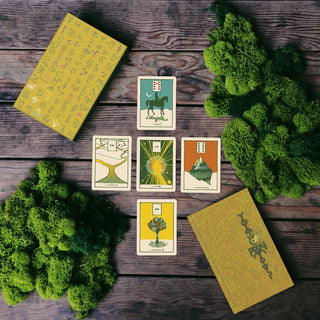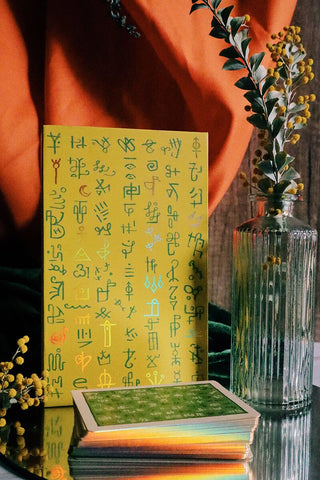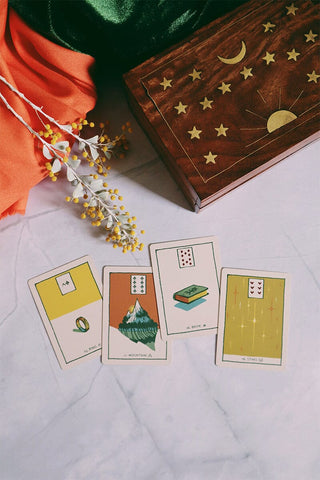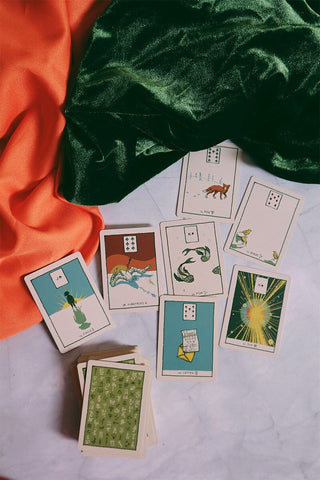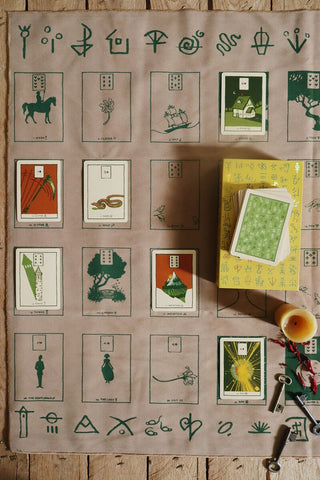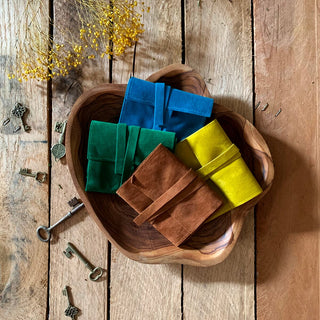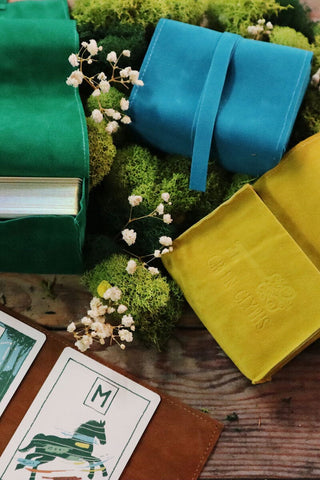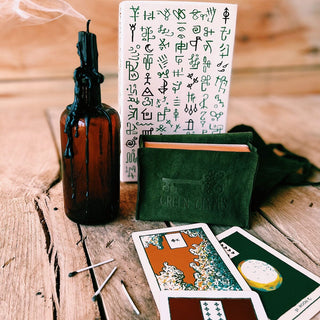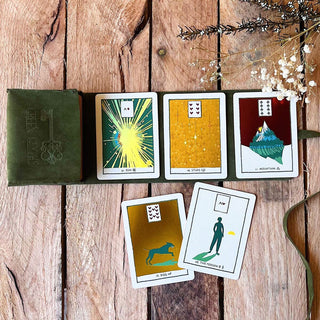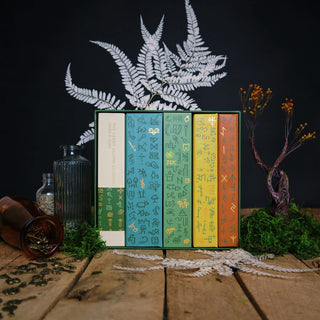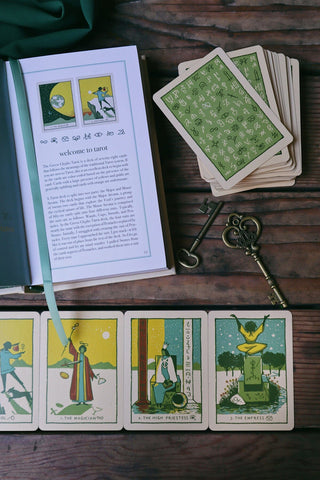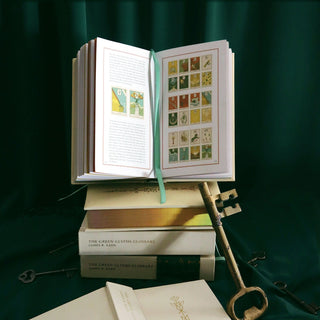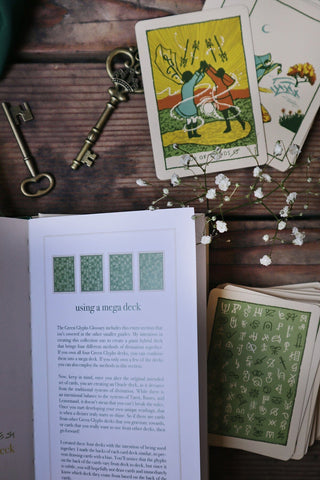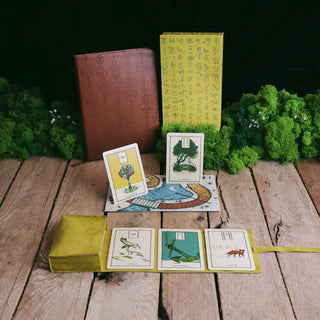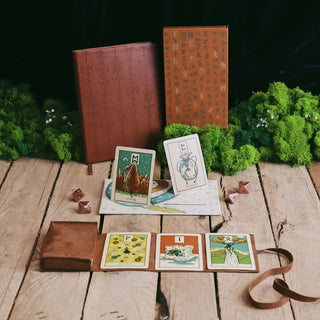GUIDE TO LENORMAND
READING LENORMAND
LENORMAND
AT FIRST GLANCE
As with every card deck, it is important to understand what the cards are saying as well as their different aspects. So, first we will dissect the Rider card as our example. On this card, you will notice several aspects.
1. The name of the card:
These names are more or less universal throughout the Lenormand world. In some decks, you might see “Rod” instead of “Whip” or “Crossroads” instead of “Paths,” but their meanings will stay the same.
2. The number on the card:
Each symbol is assigned a number from one to thirty-six that is consistent through all decks. It always begins with Rider and ends at Cross. These numbers are important because they represent which “House” the card is in. For example, “1. Rider” is in the first house, so when laying out a Grand Tableau (a spread of all thirty-six cards), whatever card falls in the 1st position will be in the House of the Rider. This House speaks of news, or things moving.
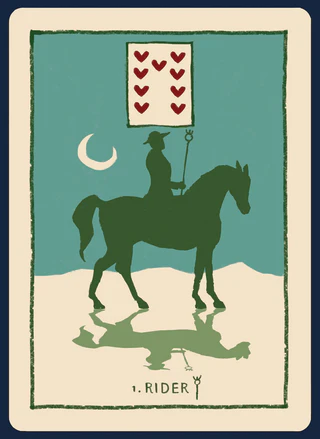
You may find it helpful to memorize or make up a mnemonic device to remember the order the cards fall in. You can also use a second deck to lay down the 36 cards in order as the base of your Grand Tableau or even the Houses of Lenormand reading cloth that I designed. Here is a mnemonic device for example:
The Rider arrives with a Clover in his pocket and heads to the Ship by the House with the big Tree. As Clouds roll in, the Snake slithers toward shelter while the men walk by carrying a Coffin decorated with a Bouquet. As they pass the barn, the man with the Scythe is cutting the grass and the Whip hangs on the wall. Birds are chirping and a Child jumps as he sees a Fox in the distance hiding from a Bear. Night falls and the sky is splattered with Stars when the Stork flies by, causing the Dog to bark. Outside of the Tower, there is a Garden with a Mountain view. There are Paths that lead away from here that only the Mice know of. But it is back in the Heart of the house where you will find the Ring. It rests in the drawer of the desk with the Book and the Letter that tells of a story of the Gentleman and his love for the Lady who offered a Lily to the Sun in exchange for the love of the Moon. The moon dropped a Key that fell past the Fish to the bottom of the sea where it rests beside the Anchor. And so the lady prays each night at the Cross, not knowing the answer to her prayers had already fallen from above.
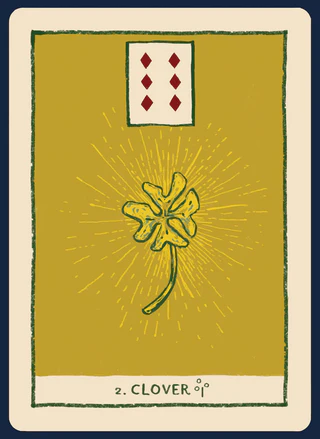
3. The small inset card:
These add a second layer to readings. Red cards can stand for yes and black cards can stand for no. The Royal cards can also signify certain people. Clubs can be challenging, spades can be proper, hearts can be affectionate and diamonds can be sharp. They can also be put on a scale, from the Kings representing extreme to the sixes representing mild.
4. The direction the illustration faces:
Some cards are directional. The Scythe for example will always face a certain direction. In this deck, the Scythe is facing right so it takes away from whatever card is to its right and gathers whatever card is to its left. Similarly, the darkness in the Cloud card is rolling to the right, so this card brings uncertainty to the following card.
5. Neutral, positive, or unfortunate?
The bulk of the cards in the deck are neutral in that they don’t add or take away from a situation and rather symbolize something. That said, there are seven cards in the deck that can be unfortunate to their surroundings: Snake, Coffin, Whip, Scythe, Clouds, Cross, and Mice. A few cards that are generally positive: Clover, Bouquet, Dog, Stars, Heart, Ring, Sun, and Key.
6. The colors:
Colors make great visual clues and can help with interpreting the meaning of the symbols. In Green Glyphs, all cards that have a strong presence of gold or yellow are positive cards while cards that are predominantly orange/brown are unfortunate.
7. Reversed cards:
There are no reversed cards in Lenormand--all cards are read face up for their meaning!
Reading Pairs
Now that you’ve become familiar with Lenormand’s symbols, it’s time to put your new knowledge to practice. The best way to begin is by reading pairs and then moving on to triplets. Once you are comfortable, you can move on to larger spreads and eventually the Grand Tableau.
The best way to start learning is to pull pairs of cards and create interpretive sentences with them. Before you begin you may want to flip through the card meanings section to familiarize yourself with this system of divination.
LILY + CLOUDS
Could mean uncertain peace, but could also mean a confused old man or a stormy winter.
SHIP + FOX
Could mean a work trip, or suspicious movement.
When reading pairs, the first card is the subject and the following card is the modifier. So if you pull SHIP + FOX, this pair is speaking about Ship with Fox describing the situation. In other words, these cards are speaking about the qualities of the trip or journey--Fox is saying that the journey will be for work or perhaps that there will be something wrong with the trip.
Let's take a look at the following example:
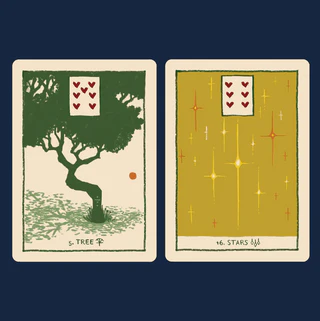
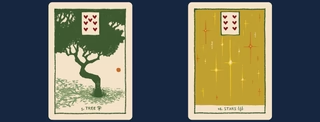
TREE + STARS
The Tree is the card we are speaking about and Stars is the card that is modifying the Tree. So here we can infer this may mean “health clears up.”
Reading pairs can be a bit harder than reading triplets or longer lines of cards as you will just read these cards in forward narration. However, it’s important to understand pairs so you can see how the placement of cards affect each other.
If we reversed the two cards we would have:
STARS + TREE
Here, Stars is the speaking card. The situation is about clarity, perhaps it can mean clarity is growing, or spiritual clarity.
Reading pairs can be a bit harder than reading triplets or longer lines of cards as you will just read these cards in forward narration. However, it's important to understand pairs so you can see how the placement of cards affect each other.
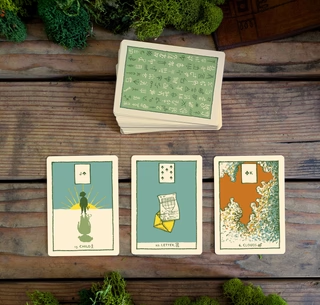
Reading Triplets
Once you are comfortable with pairs and you begin to read triplets, the magic of Lenormand will start to appear. You’ll be developing more of a story, and slowly, more and more information will be built up.
Try pulling some triplets as you did with the pairs. Here are some examples:
CLOVER + SCYTHE + TREE = minor surgery
DOG + LETTER + FISH = a friend sends you money
PATHS + SUN + FOX = bright options ahead at work
SHIP + HOUSE + GARDEN = welcome home party
chaining and mirroring
After you get comfortable with triplets, you can start reading them in a different order to add even more depth. This is sometimes referred to as “chaining” or “mirroring.” An example:
CHILD + LETTER + CLOUDS = the note about the kid was unclear
CHILD + LETTER = there is a note about a kid
CHILD + CLOUDS = this unclarity is new
LETTER + CLOUDS = the letter was vague
By linking the different symbols in the situation together to form individual sentences, you can interpret even more from the situation. By mirroring and chaining, we can learn that perhaps the illegible note was something new and might need to be explained further by speaking with the child. Chaining and mirroring is a good example of how Lenormand cards are read by proximity rather than placement.
Reading in a line
Once you are comfortable with reading triplets, you can move onto lines of five or seven cards. With these readings, you begin to get more pieces to the puzzle. Reading a line is a good option when you are inquiring about something in the near future, like within the week, whereas a Grand Tableau is better for reading the bigger picture.
Keep in mind that when you are doing a reading only involving three or five or seven cards, the intensity of the cards’ meanings are turned down. For example, Cross will likely symbolize something annoying or disruptive hap.pening, not a heavy burden. Likewise, Fish might symbolize finding five dollars on the ground rather than a flow of cash. When reading all thirty-six cards in the Grand Tableau, something that mundane would likely not come up.
There are two methods for pulling cards for this type of reading. The first is to “activate” your focus card. This card will vary depending on what you are asking about. If it is a question about your family, you would activate House. If it is a question about work, you would activate Fox. To activate a card in a five-card line, then shuffle the deck while thinking about the card you want to activate. Then search for the card in the deck and pull out the two cards before it and the two cards after it.
The activated card will be in the center, the two cards that came before it will be in the first and second positions, and the two cards after it will lie in the fourth and fifth positions. In the example below, let's say John wants to know how his flight to New York will go on Friday. Ship will be the activated card and we will shuffle the deck well while focusing on this card. Afterwards, search for the Ship card within the deck and pull out the two cards before it and the two cards after it and place them in the order they came in:
MOUNTAIN + BIRDS + SHIP + CLOUDS + CLOVER
We can infer from this combination that his flight could be delayed, which could make him nervous about missing the event he is heading to. Ship is then followed by Clouds which could suggest bad weather, but then the line ends with Clover, which puts a small joyous ending on the situation. It’s possible that the trip will be delayed enough to make him worry, and even after we take off, he’ll be unsure if he’ll make it in time, but at the end a little luck will come his way. If you prefer to let the deck speak for you and not to activate a card, you can do a line reading by shuffling the deck and pulling the top five or seven cards. With this method, you don’t need to have a question in mind--the deck will decide what to tell you about. If the focus card doesn’t make any sense to you, think hard on what is happening in your life in the next week. If still nothing comes to mind, shuffle and try it again.
PAINTING THE PORTRAIT
The interactions between the placement of cards in this spread of nine will be helpful when reading a Grand Tableau. The Portrait reading puts a focus on the card in the center. Shuffle the deck well, split it in half, and then put it back together. Deal the top nine cards in rows of three. The center card is the significator, the querent, or whoever is doing the reading. Imagine this is a portrait, with the character represented in the center and their story and influences surrounding them. To the left of the significator is the recent past. To the right is the near future. Above the significator is their current motivations, and to the left of that are their past influences, with the card on the right belonging to the future of their conscious motivations. The bottom row of cards deals with the unconscious, either what we do not realize influences us or what outside forces are intertwined with our lives. The card on the left is past unconscious influences, the card center bottom is what grounds you now in this moment, and the card to the right is what consequences are to come of your unconscious actions. The bottom row can be the most abstract to read, but can often be what is driving the events themselves. You will be able to use this knowledge in reading a Grand Tableau.
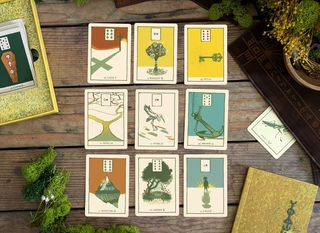
In the example above we have the Stork as the center card in the portrait. This signifies that the querent is someone going through change, or asking a question about changes. Immediately we can look at color and see two orange cards on the left column and two yellow above the significator. This is a good sign. The hard things are behind and they are on the way to new and better things. First read the left column (Cross + Paths + Mountain) as challenging options have led to further obstacles. Just from this first line we can infer the querent has recently been going through some hard times. Now read the center column (Bouquet + Stork + Garden) as a variety of public or visible changes are happening currently.
Next we will read the future column (Key + Anchor + Child) as success will come and lead to new stability. Anchor is the card coming next in the querent’s life and so is important to look at. Anchor is the card that is about stability and security, nearly the opposite of Stork. It’s likely that this person is in need of some stability, so the Anchor is a welcome sign. We can also look at the card the Key is pointing to (Bouquet) to infer that small joys, gifts or pleasures will be key in feeling stable. The cards beneath the significator (Mountain + Tree + Child) speak to the unknown forces that impact the querent. These cards say that obstacles will lead to new growth. This is what is the hardest for the querent to see. These are the things that impact us that we have little control over: they happen un.consciously and are usually not on the mind. The top three cards speak to what has been and will be on the querent’s mind. So, Cross + Bouquet + Key suggests that faith has illuminated the importance of the small joys in life.
Next we would look at the cards at the four corners of the portrait--these will speak about the issue itself. Cross + Child + Key + Mountain means that new burdens have only lead to delayed answers.
Finally, read the cards in a diamond for insight on what might be hidden in the situation (Bouquet + Paths + Tree + Anchor) Which tells us that a variety of options in the querent’s life may be what is stunting growth. Perhaps the querent should try to lessen the amount of choices in front of them.
So, you can see that from reading only nine cards we can gather a lot of information about a situation, even without a question at hand. Now, give it a try, and paint a portrait for yourself. See how much you can infer from the simple nine-card spread.
using the inset pips
There are many ways to use the inset pip cards in readings. In fact, they can even be used as the primary part of a reading. The inset pips are more useful in readings with fewer cards. In the Grand Tableau, there is already more than enough information going around.
Generally, the four suits lie in the following categories:
Clubs: mostly unfortunate cards, and are about more complex things in life. Can indicate a strong “no”.
Spades: relate to activity and business, and give structure to things. Can indicate a “probably not”.
Hearts: these cards deal with emotions, love and growth. Can indicate a strong “yes!”.
Diamonds: encompass more abstract things like luck, decisions, and wisdom. Can indicate a “maybe”.
When asking a “yes or no” question, you can pull five or seven cards (must be odd, should be more than three) and count the red pips versus the black pips. Red pips represent “yes” and black pips represent “no.” A spread with all black pips would indicate a strong “no” while all red would indicate a strong “yes.” If there is a mix that leans one way, it is a softer “yes” or “no.”
Adding depth to a reading
You can also use the pips to add another layer of understanding to a reading or a combination of cards. It’s helpful to start with a triplet and go from there.
For example, Paths + Ring + Tree could be speaking about a decision that leads to a growing partnership. Looking at the pips, we have a Diamond card, a Club card, and a Heart card. The presence of a Club can be challenging, and if there was another one, it might say that this partnership will be a challenging one. But with the presence of a Heart and a Diamond card, it affirms that this union will be healthy. Reading the pips in terms of a yes or no can also translate to good or bad. We have two red cards (Hearts, which is astoundingly good) and one black card (Clubs, which is the most unfortunate). These two cards will cancel each other out leaving the Diamond card Paths, which is a slightly positive outcome.
Counting pips
Counting the pips is a way to find a hidden influence or a secret blessing in a reading with fewer than nine cards.
With this method, add up the pips in a sequence. The number they add up to will be equivalent to a card in Lenormand. If the number is above thirty-six, subtract the extra amount. For example, if you end up with forty-five you would subtract thirty-six from forty-five and get nine, BOUQUET.
Aces = 1
Jacks = 11
Queens = 12
Kings = 13
Here is an example of how you would count:
BOOK + RIDER + MOUNTAIN + MOON + KEY
10 + 9 + 8 + 8 + 8 = 43 (-36) = 7, SNAKE.
So, while the situation above speaks about the news of a secret becoming a challenge that will be overcome by emotion, we can see that the snake is the hidden influence here and that desire is something to pay attention to.
DECODING THE CARDS
In the next section, you will find key words behind each card’s symbolism. Keep in mind, there are many more interpretations not listed. These are to give you an idea of what each card represents. Some words that fall under the same card may seem contradictory, but the meaning of the card can change depending on the situation at hand. When you first start reading, begin with simple situations like “What will happen at work in the following weeks?” That makes the frame of the cards your workplace, which will make it easier to interpret. For example, if Whip comes up, it most likely means “conflict” rather than “fitness.”
Because the meanings behind some cards are so broad, and some meanings seem like they don’t apply to you specifically, it is important to understand what each card means for your individual reading.
Let’s take the Tower card for example. Generally, Tower stands for school, government, hospital, corporation, or other big buildings. When you are doing a reading for yourself and Tower comes up, assign Tower to your workplace or school. This then tells you that every time you see the Tower come up, you should look at the surrounding cards to understand the situation at work/school.
The same goes for Bear. This card can mean power, strength, mother, or a big chunk of money. It can be a little daunting when there are many meanings for a single card, so choose one that resonates with you to begin. As you become more familiar with Lenormand, you will be able to apply the other meanings of the card.
Learn about the rest of the cards below.



